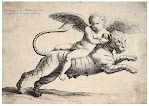
I am always astonished by the connectedness of things. Nothing is discrete. Every action, thought or sensation is embedded with all others. The work of consciousness is selecting which connections to value, which to ignore.
Today I went hiking after a heavy rain, and when I returned to my car I found that a wolf spider had taken up residence in the cup holder of my car. I suppose she was looking for a dry spot. I like wolf spiders, so I let her stay and she rode around with me all day. I went to a violin lesson, made a grocery run, met Dave for coffee, drove the 40+ miles back to my house--and the spider stayed right there in my cup holder. A couple of times she climbed up to the edge and waved a leg in my direction, but mostly she just hung out at the bottom of the well, happy with her new home. I won't be surprised if she's still there in the morning.
My new buddy seemed to beg for a blog post, so I went looking for a spider poem, but couldn't find a good one that seemed appropriate. The way she hitched a ride made me think of hitchhikers, so I switched to searching for hitchhiker themes, and found the outstanding Diane Wakoski work below. One of the reasons it caught my attention is its recurring image of the mountain ash tree. I recently had an exchange about the fruit of the mountain ash--also known as the rowan tree--with Olfacta at her blog.
I love that perfect circle of event, art and memory.
They burn you
like the berries of mountain ash in August,
standing by the road,
clearly defined,
Autumnal brilliant, heads
scorched from waiting
in the sun.
How can
you pass them up?
But you do,
and dream each night of a hell,
where you are a hitchhiker,
and no one will ever stop to pick you up....(more)
From "The Hitchhikers" by Diane Wakoski, 1977. Complete text at Poetry Foundation.
Photo of wolf spider carrying her young on her back by Clinton and Charles Robertson, from Wikimedia Commons.






